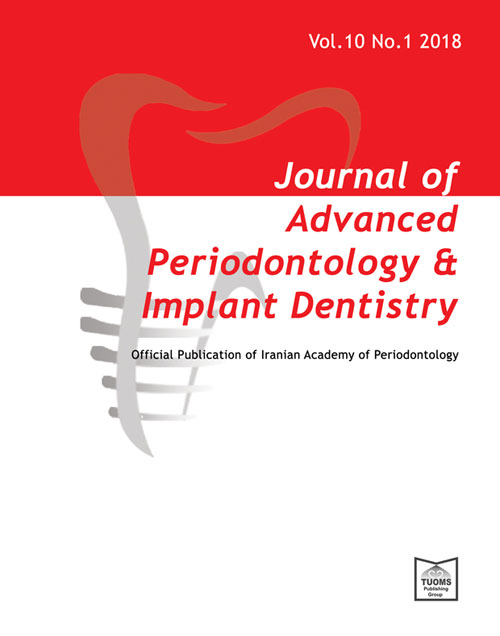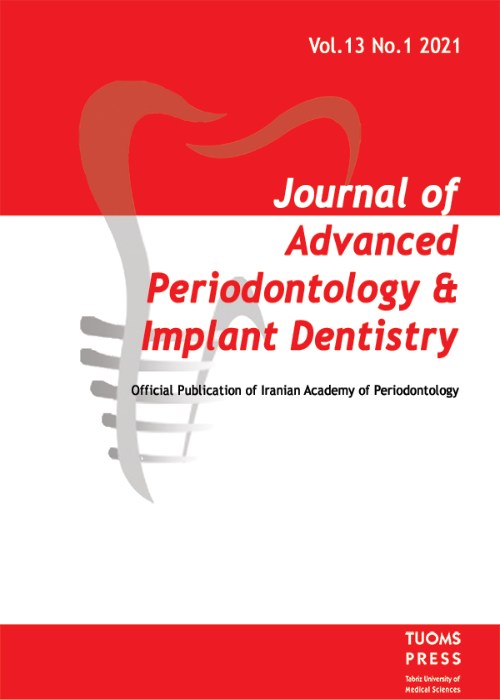فهرست مطالب

Journal of Advanced Periodontology and Implant Dentistry
Volume:11 Issue: 2, Dec 2019
- تاریخ انتشار: 1399/03/03
- تعداد عناوین: 8
-
-
Pages 49-53Background
The main objective of thissystematic review wasto identify the hemodynamic effects of intravenous sedatives used in dental implant surgeries.
MethodsEmbase, PubMed, ProQuest, Scopus, Ovid, and Cochrane databases were searched with no limitations. Of 59 studies obtained, 50 studies were excluded due to incompatibility with the subject. The remaining studies were reviewed in full text and assessed for the risk of bias individually. The included studies were reviewed by the research team, and the necessary data were extracted.
ResultsFour studies were finally included. Two of the studies compared local anesthesia and intravenous sedation, while the other two compared the consequences of different types of intravenous sedation. By comparing the hemodynamic effects, the systolic and diastolic blood pressure and the heart rate data were collated. Midazolam was the most frequently used intravenous sedative, and Dexmedetomidine affected hemodynamics the most.
ConclusionIntravenous sedation leads to decreased heart rate and blood pressure. Better hemodynamic outcomes improve the patients’ cooperation by decreasing stress and anxiety. Dexmedetomidine seems to be the first choice for intravenous sedation.
Keywords: Dental implants, hemodynamic effects, intravenous sedation -
Pages 54-62Background
There is limited data available on potential biological effects of E-cigarettes on human oral tissues. The aim of this study was to evaluate the effects of E-cigarette liquid on the proliferation of normal and cancerous monolayer and 3D models of human oral mucosa and oral wound healing after short-term and medium-term exposure.
MethodsNormal human oral fibroblasts (NOF), immortalized OKF6-TERET-2 human oral keratinocytes, and cancerous TR146 keratinocyte monolayer cultures and 3D tissue engineered oral mucosal models were exposed to different concentrations (0.1%, 1%, 5% and 10%) of E-cigarette liquid (12 mg/ml nicotine) for 1 hour daily for three days and for 7 days. Tissue viability was monitored using the PrestoBlue assay. Wounds were also produced in the middle surface of the monolayer systems vertically using a disposable cell scraper. The alterations in the cell morphology and wound healing were visualized using light microscopy and histological examination.
ResultsStatistical analysis showed medium-term exposure of TR146 keratinocytes to 5% and 10% E-liquid concentrations significantly increased the viability of the cancer cells compared to the negative control. Short-term exposure of NOFs to 10% E-liquid significantly reduced the cell viability, whereas medium-term exposure to all E-liquid concentrations significantly reduced the NOF cells’ viability. OKF6 cells exhibited significantly lower viability following short-term and mediumterm exposure to all E-cigarette concentrations compared to the negative control. 3D oral mucosal model containing normal oral fibroblasts and keratinocytes showed significant reduction in tissue viability after exposure to 10% E-liquid, whereas medium-term exposure resulted in significantly lower viability in 5% and 10% concentration groups compared to the negative control. There was a statistically significant difference in wound healing times of both NOF and OKF6 cells after exposure to 1%, 5% and 10% E-cigarette liquid.
ConclusionMedium-term exposure to high concentrations of the E-cigarette liquid had cytotoxic effects on normal human oral fibroblasts and OKF6 keratinocytes, but a stimulatory cumulative effect on the growth of cancerous TR146 keratinocyte cells as assessed by the PrestoBlue assay and histological evaluation of 3D oral mucosal models. In addition, E-liquid exposure prolonged the wound healing of NOF and OKF6 oral mucosa cells.
Keywords: Electronic cigarette, cytotoxicity, keratinocyte, fibroblast, tissue engineering, wound healin -
Pages 63-68Background
Chemical plaque control, an adjunct to mechanical approaches, could improve the maintenance of patients with different types of periodontitis. Chlorhexidine, the gold standard in chemical plaque control, might have some side effects; the most determining one is tooth discoloration. Anti-discoloration systems (ADS) have been added to minimize brownish tooth discoloration. This study aimed to evaluate the staining potential and clinical efficacy of chlorhexidine with and without ADS in patients with chronic periodontitis.
MethodsIn this randomized controlled trial, 46 patients with chronic periodontitis were randomly allocated to two groups. Each patient used 10 mL of mouthwash A (CHX without ADS) or B (CHX with ADS, including sodium metabisulfite and ascorbic acid) twice a day for two weeks. After a two-week interval, they used the second mouthwash. At the beginning and the end of each two-week cycle, plaque index (PI), bleeding on probing (BoP), and staining index were recorded.
Results
There was no significant difference between mouthwash A and B in the reduction of BoP and PI. The staining index was significantly lower after rinsing with mouthwash B compared to mouthwash A.
ConclusionCHX mouthwash containing ADS has similar efficacy in microbial plaque control and reduction of BOP as CHX without ADS, with the advantage of lower stain formation on tooth surfaces in patients with chronic periodontitis.
Keywords: Anti-discoloration system, bleeding on probing, chlorhexidine, mouthwash, periodontitis, plaque control, staining -
Pages 69-76Background
Pharmacological factors, such as ibuprofen, released topically in the periodontal pocket modulate the host response and enhance the influence of non-surgical periodontal treatment.
MethodsIn this double-blind, randomized, split-mouth, clinical trial, 38 outpatients with mild to moderate chronic periodontitis were enrolled by applying the simple random sampling method. They had at least one tooth with a periodontal pocket depth of >4 mm in each quadrant and had undergone phase I of periodontal treatment one week after scaling and root planing (SRP). The parameters of clinical periodontal evaluation, including probing pocket depth (PPD), clinical attachment level (CAL), plaque index (PI), and bleeding index (BI), were measured. In addition, two mandibular molar teeth in one quadrant were randomly nominated for subgingival irrigation with 0.5 mL of 2% ibuprofen or placebo mouthwash. The measurements were repeated after at least one week for three months.
ResultsThirty-four individuals (18 women and 16 men), with an age range of 28‒36 years, were evaluated for three months. Moreover, periodontal clinical parameters were assessed within three months. There was a significant improvement in pocket depth (PD) and clinical attachment level (CAL) readings after 12 weeks in both groups (paired t-test). On comparing, the group with scaling and root planing (SRP) + ibuprofen showed more favorable results than the group with SRP + placebo (P<0.05). There were significant improvements in PI and BI in both groups; the differences between the two groups were significant (P<0.05).
ConclusionThe mouthwashes containing ibuprofen might reduce the symptoms of periodontal disease and might be used as an adjunct in the healing process.
Keywords: Chronic periodontitis, ibuprofen, irrigation, non-surgical, periodontal therapy -
Pages 77-84Background
Evidence is limited on the effect of periodontal treatment on improving HbA1c levels in non-diabetic patients with chronic periodontitis. This study aimed to compare HbA1c levels in non-diabetic patients without periodontitis and nondiabetic patients with chronic periodontitis at baseline and to evaluate the effect of non-surgical periodontal treatment on glycemic control in non-diabetic chronic periodontitis patients.
MethodsIn this interventional study, 30 non-diabetics, aged 35‒65 years, were selected and divided into two groups (n=15). Group A consisted of non-diabetics without periodontitis, and group B consisted of non-diabetics with mild to moderate chronic periodontitis. For all the subjects, periodontal parameters, including plaque index, gingival index, periodontal pocket depth, and clinical attachment loss, and laboratory parameters of FBS and HbA1c were measured and recorded. Independentsamples t-test was used to compare periodontal and laboratory parameters between the two groups; paired-samples t-test was used for intra-group comparisons.
ResultsHbA1c level in group B (5.4±0.42%) was significantly higher than that in group A (5.04±0.43%) (P=0.03) at baseline. Three months after treatment, improvements were achieved in all the periodontal parameters in group B, with a significant decrease in HbA1c levels (P=0.006).
ConclusionNon-surgical periodontal treatment resulted in a significant decrease in HbA1c levels in non-diabetic patients with chronic periodontitis. Although these levels did not reach the level of non-diabetic patients without periodontitis, it could be concluded that an improvement in the periodontal condition might lead to near-normal glycemic levels
Keywords: Blood glucose, diabetes mellitus, glycated hemoglobin A, non-surgical periodontal debridement, periodontiti -
Pages 85-93Background
Thisstudy aimed to compare the effect of one and two sessions of antimicrobial photodynamic therapy (aPDT) as an adjunct to scaling and root planing (SRP) on clinical and microbial parameters in patients with chronic periodontitis.
MethodsThis study was conducted on 20 patients. The dental quadrants of patients were randomly assigned to SRP at baseline (group 1), SRP at baseline and one month (group 2), SRP plus aPDT at baseline (group 3) and SRP plus aPDT at baseline and one month (group 4). Probing depth (PD), clinical attachment level (CAL) gain, and bleeding on probing (BoP) were measured at baseline, and one and three months later. F. nucleatum counts were determined by PCR. ANOVA was used for the comparison of these variables between the groups.
ResultsIn all the groups, PD reduction and CAL gain increased significantly at 1- and 3-month intervals compared to baseline (P=0.001). At three months, the difference in PD between groups 1 and 3 was statistically significant (P=0.014). CAL gain between groups 2 and 4 at one month (P=0.016) and three months (P=0.001) wasstatistically significant. Reduction in F. nucleatum counts was not significant between the four study groups (P>0.05).
ConclusionA combination of two sessions of aPDT and SRP could improve CAL gain; however, further long-term studies are necessary in this regard.
Keywords: Chronic periodontitis, non-surgical periodontal therapy, photodynamic therapy, scaling, root planing -
Pages 94-98Background
Bone augmentation ensures a favorable 3-dimensional position of implants. Onlay grafting is one of the techniques in ridge augmentation, which can be performed with the use of xenogenous blocks.
MethodsThree cases of the vertical and horizontal ridge are discussed, which were augmented using xenogenous blocks. The blocks were shaped in a favorable size and puzzled along the grafting area. All the gaps were filled with granular xenografts. The flaps were coronally advanced to obtain primary closure.
ResultsAn average of 4.2-mm gain in width and 4.2-mm gain in height of the ridge was observed at the implantation stage.
ConclusionThe outcomes of these cases could pave the way for suggesting xenograft blocks for augmenting wide areas of the alveolar ridge on average of 4 mm in width and height in selected cases as an alternative to standard autogenous blocks. Long-lasting xenograft ensures implant and lip support in the esthetic zone
Keywords: Alveolar bone grafting, alveolar bone loss, Heterograf


